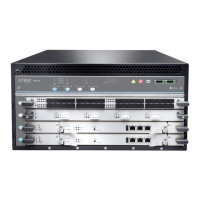After the Esc key is pressed, Esc is pressed. Go to boot options. is displayed on the
screen.
4. Using Up or Down arrow keys, navigate to Boot Manager and press the Enter key.
5. Using Up or Down arrow keys, navigate through the EFI boot devices listed and select
EFI Network 0 for IPv4 to boot from the PXEboot server and press the Enter key.
6. Booting `net boot console is displayed and PXEBoot continues.
NOTE: The booting process may take several minutes.
7. After the Routing Engine boots, press y when you are prompted to confirm Install
vmhost and Junos software on Primary and Secondary disk [y/N]? on the console.
8. After the installation is completed, press y when prompted to confirm Reboot now?
[y/N]? to reboot from the SSD disk.
Copying vmhost and Junos OS when only one disk is replaced:
a. Bring the Routing Engine online by pressing the ONLINE/OFFLINE button.
b. The router boots from disk1 if disk2 is replaced. To be able to boot from disk2:
user@host> request vmhost snapshot partition
The router boots from disk2 if disk1 is replaced. To be able to boot from disk1:
user@host> request vmhost snapshot recovery partition
Related
Documentation
Returning a Hardware Component to Juniper Networks, Inc. on page 432•
• Upgrading the SSD Firmware on RE-S-X6-64G and RE-MX2K-X8-64G Routing Engines
Replacing Connections to MX240 Routing Engine Interface Ports
•
Replacing the Management Ethernet Cable on an MX240 Router on page 286
•
Replacing the Console or Auxiliary Cable on an MX240 Router on page 286
285Copyright © 2017, Juniper Networks, Inc.
Chapter 24: Replacing Host Subsystem Components

